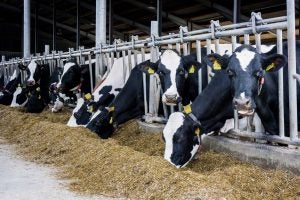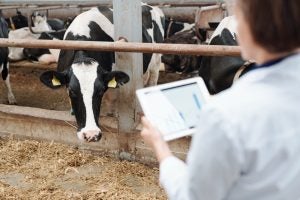It always amazes me to learn how farming practices are improving and progressing. The industry is always making strides on efficiency, productivity, and sustainability. And that’s not because government regulations require it; it’s what happens when an industry embraces science, innovation, and work ethic.
Modern dairy farms are no exception. A cow today can produce 100 pounds of milk with 40 percent less feed than she did around 30 years ago. And over the past 15 years, U.S. farmers are milking 930,000 fewer animals, but still producing the same amount of milk.
So how are they doing it? Let’s take a stroll through the hallmarks of sustainable dairy.

Precision Nutrition. Healthy cows produce more milk. Although nutrition management has always been key to profitable farms, advanced technology is allowing precision nutrition to take center stage. Farmers now have access to sophisticated software and tools that precisely analyze the nutritional needs of their cows. By monitoring individual cow health and milk production data, farmers can formulate personalized diets that optimize both productivity and well-being. When implemented correctly, precision feeding should reduce environmental emissions, reduce feeding costs, and improve feed efficiency.
Robotic Milking Systems. We’ve come a long way from milk maids spending their days hand milking cows. Automatic milking systems were originally developed in Europe to address labor issues on farms. These high-tech machines utilize sensors to identify individual cows and administer milking accordingly. These are voluntary milking systems that allow cows to make their own milk schedule, reducing stress and increasing comfort. The technology is equipped to collect information on milk quality and quantity, as well as cow health. Farmers earn back some of their time and can use the data to improve herd management.
Incorporating Renewable Energy. Dairy farmers are increasingly finding ways to incorporate renewable energy sources into their operations. Solar panels and wind turbines can be creatively placed in pastures to harness renewable energy while reducing reliance on fossil fuels. Scientists are exploring how adding solar panels to pasture impacts the cows, and whether it has any impact on milk quantity or quality. By harnessing the power of the sun and wind, these farms can offset their energy consumption and even contribute surplus energy back to the grid.
Manure Efficiency. Farmers used to treat manure as … well, waste. But manure has emerged as a valuable resource for sustainable dairy farms. Innovations in anaerobic digestion systems allow farmers to convert manure into biogas, a renewable energy source. This biogas can be used to generate electricity or heat, providing a reliable and eco-friendly alternative to fossil fuels. Additionally, the remaining byproduct, known as digestate, serves as nutrient-rich fertilizer, promoting soil health and reducing the need for synthetic fertilizers.

Data Driven Management. The digital age has transformed dairy farming into a data-driven industry. Advanced sensors and monitoring systems collect real-time data on cow behavior, milk production, and environmental conditions. By analyzing this data, farmers can make informed decisions that optimize herd health and minimize resource wastage. From early disease detection to optimizing ventilation systems, technology empowers farmers to proactively manage their operations, resulting in improved animal welfare and reduced environmental impact.
Dairy farmers across the country are finding new ways to advance the industry by embracing innovation and science. In return, we’re seeing healthier cows, increased milk production, and less resource use. I have no doubt that dairy farms, like all of agriculture, will find new ways to meet today’s challenges and tomorrow’s demands.
Amanda Zaluckyj blogs under the name The Farmer’s Daughter USA. Her goal is to promote farmers and tackle the misinformation swirling around the U.S. food industry.



